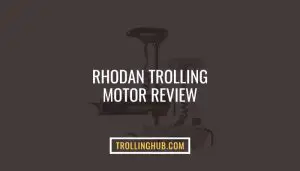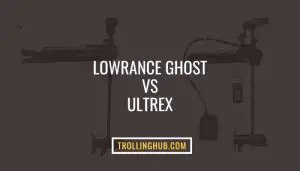In the battle of Garmin Force vs Lowrance Ghost, it’s hard to choose a winner. It all comes down to brand preference. They both have state-of-the-art brushless DC electric motors and perform well for most anglers.
They’re both quite similar in terms of features, the main differences being in shaft length options and thrust options. The Garmin Force also has a unique gesture control feature that is not available on any other trolling motors. But to find out which one will suit your needs, you have to do your research. Luckily, I’ve done that for you!
Quick Comparison Table
| Features | Garmin Force | Lowrance Ghost |
| Shaft Length | 50”, 57” | 47”, 52”, 60” |
| Thrust | 80lbs, 100lbs | 97lbs, 120lbs |
| Use | Freshwater, Saltwater, Brackish water | Freshwater |
| 360 Degree Breakaway | No | Yes |
| Steering | Electric Steering | Fly-By-Wire Steering |
| Floating Remote | Yes | No |
| Gesture Features | Yes | No |
| Price | 3549 – 3649 USD | 3499 – 3749 USD |
Garmin Force Overview
Released in January of 2020, the Garmin Force is a highly efficient trolling motor that is designed for use in both saltwater and freshwater. It comes with the latest features, and is one of quietest trolling motors out there.
What I Like About Garmin Force Trolling Motor
- The gesture control feature is the coolest!
- Very quiet
- Ability to handle either the 24V or the 36V automatically
- Adapted to both freshwater and saltwater
- Responds the same as a cable steer-type trolling motor
- Adding on the Garmin Panoptix makes the experience significantly better
- Advanced cruise control features
What I Don’t Like About Garmin Force Trolling Motor
- Slight resistance to the foot pedal
- Takes time to get used to the foot pedal buttons
- No breakaway shaft
- Heavier and harder to deploy and stow
Lowrance Ghost Overview
The Lowrance Ghost was released in January 2019 and is Lowrance Electronics’ first brushless motor with integrated sonar capabilities and a lot of advanced features. Lowrance claims that it has the “most thrust and the longest run time of any trolling motor on the market!”
What I Like About Lowrance Ghost Trolling Motor
- More options with shaft length
- Higher thrust options
- Doesn’t have any sonar interference
- You can customize the foot pedal functions
- Easy to get accustomed to
- 360 Degree breakaway mount is super useful for rocky areas
- Efficient battery
What I Don’t Like About Lowrance GhostTrolling Motor
- Not suitable for saltwater
- Isn’t as powerful in practice as it is on paper
- Noisier underwater
Garmin Force Vs Lowrance Ghost
When deciding between two very similar motors, your reason for troll fishing may affect the verdict. So here’s a more head-to-head comparison of various features, so you can decide for yourself which one you like.
Build Quality & Design
Verdict: Tie
The Lowrance Ghost’s housing is made from anodized aluminum, which is durable and can withstand scratches. It has a stainless steel shaft and a brushless motor. All of which makes the Ghost durable and resistant to damage.
The Garmin Force on the other hand features a composite housing and also has a composite shaft. While stainless and aluminum are more durable and resistant to scratching, composite materials are lighter and corrosion-resistant. Composite shafts are also more flexible and won’t break as easily.
So each of these has its perks. Both Garmin and Lowrance Electronics are trusted brands that are experts at their manufacturing game. It is no wonder that both of these trolling motors, therefore, are of excellent quality.
Thrust
Verdict: Lowrance Ghost has a higher thrust.
The Lowrance Ghost offers higher thrust options and is more powerful on paper. It gives you the option to choose between 120 lbs at 36 volts or 97 lbs at 24 volts.
With the Garmin Force, you get to choose between 100 lbs at 36 volts or 80 lbs at 24V. While the Lowrance offers higher thrust, in practice a lot of anglers have experienced that the Garmin can be more powerful, topping out at around 3.8mph whereas the Lowrance peaks at 3.25mph.
This just shows your angling experience might not always reflect what’s on the specs sheet.
However, they’re still both powerful enough for most trolling conditions and won’t have much problem even with larger boats. The difference is pretty small, but since experiences can vary, the winner here has to be Lowrance, at least on paper.
Battery
Verdict: Tie
When it comes to batteries, these two are at par with each other. They both have 24V or 36V options and can function just as well both either. You don’t need a separate model for a different electric battery setting.
And being brushless motors, they are very efficient. Even after spending a six-hour trolling day on the boat, you will return with more than half the battery left and won’t have to recharge right away.
So the chances of you running out of battery mid-way and having to ruin your troll trip is very unlikely.
Control System
Verdict: The Garmin Force has unique gesture control features!
Perhaps the coolest feature of the Garmin Trolling Motor is its gesture control. You simply have to point the remote control in the direction you want to go, and the wireless remote will send signals to the motor to steer the boat in that direction.
You can also use the remote control to change your steering or even use a Chartplotter from Garmin! There’s also the option to control the steering with your foot pedal as well. So plenty of options to give you the most freedom.
With the Lowrance, you get pretty much the basic features you can expect. You can use the foot pedal to steer, the wireless remote, or buy Lowrance fishfinder electronics to help you. It has Fly-By-Wire steering as opposed to the electric steering on the Garmin.
Shaft
Verdict: Lowrance Force has more options
Sometimes even a 2-inch extra shaft length can make a difference in whether your motor hits an obstacle underwater. So it’s always better to have more options when choosing a shaft length. The Lowrance Force offers you multiple choices from 47″, 52″ or 60″ shaft lengths.
On the other hand, with Garmin, you can only get two. The Garmin Force longer shaft is 57”, while the shorter one is 50”. The shafts on this are made with composite materials, which are less prone to breakage though. So even if you do hit obstacles, it’s unlikely that the shaft will be damaged.
GPS Features
Verdict: Tie
The Garmin Force features a built-in Global Positioning System antenna that provides accurate location information. The GPS is compatible with the Garmin ActiveCaptain app, which allows users to plan and create routes, view maps, and access real-time information.
You can use it with Garmin Quickdraw Contours mapping software, which enables users to create custom fishing maps that can be shared with the community.
The Garmin Force is also designed to work with a range of chartplotter systems, including the Garmin ECHOMAP Ultra and the Garmin GPSMAP series.
The Lowrance Ghost also has a built-in GPS, which is compatible with the Lowrance C-Map charts, which provide detailed mapping and navigation information for coastal and inland waterways.
The GPS is compatible with the Lowrance Ghost app, which allows users to access and control the trolling motor, as well as view maps and navigation data. You can use a range of chartplotter systems, including the Lowrance HDS LIVE and the Simrad NSS evo3.
Both GPS systems offer Anchor Lock or Spot-Lock, at the push of a button on the foot pedal. There are also Auto Pilot features that you can use to set and control paths.
Sonar Performance
Verdict: Garmin Force is compatible with the Livescope Panoptix, which makes it futureproof.
The Garmin Force is compatible with a wide range of transducer options. You can pair it up with CHIRP sonar, ClearVu, SideVu, etc. It supports frequencies of High-wide CHIRP (150-240 kHz), Ultra-high-definition 800 kHz, and Ultra-high definition 1200 kHz and 455 kHz.
And since Garmin Force is therefore compatible with various Garmin fishfinders, you have the option to the Livescope Panoptix system that is sold as an accessory with the Garmin.
Panoptix is a type of sonar technology developed by Garmin that provides a highly advanced and detailed view of the underwater environment.
Unlike traditional sonar, which sends a single beam of sound waves directly below the boat, Panoptix uses a multi-beam scanning sonar to provide a real-time, 3D view of the underwater world around the boat.
While there’s a similar option available for Lowrance as well, called the Lowrance Livescope, the Panoptix performs much better and is much more advanced.
But the Lowrance Sonar specs are still pretty good. They support frequencies of Medium/High Chirp Sonar, 455/800 kHz, and have a built-in HDI sonar Nosecone.
Is Garmin Better Than Lowrance?
So is the Lowrance Ghost worth it or is Garmin Force trolling motor worth it? The answer depends on you and your preferences.
They are both worth their price and give great value for money. Since they cost around the same, you can make your decision depending on which features are important to you.
Who Should Buy Garmin Force
One way to quickly choose an experienced angler is to see what you already have. If you have Garmin electronics, fishfinders, or other accessories that only work with Garmin motors, then buying the Garmin Force is the way to go.
Along with its cool gesture-steer feature Garmin Force also offers a unique float feature on their remotes. This not only means they are waterproof, but that they will float if you accidentally drop them in water.
And finally, if you’re someone who changes between saltwater and freshwater trolling, then Garmin is the one for you.
Who Should Buy Lowrance Ghost
Similarly, if you already own Lowrance electronics, you should opt for the Lowrance Ghost so that your accessories don’t go to waste.
Secondly, if you need more options with shaft length or need a longer length, then Lowrance is the right one for you.
Their 360 breakaway mount is also super useful, especially if you’re someone who trolls rocky areas. Fewer chances of the shaft breaking off the lower unit.
And finally, the customizable foot pedal is also a deciding feature for many anglers, who don’t want to spend time adjusting to new settings. You can program them to the way you’re already used to.
FAQs
While both the Lowrance Ghost and Garmin Force are brushless motors and are significantly quieter than other motors on the market, some anglers report that the Garmin Force is the quietest trolling motor overall.
No, the iPilot is a proprietary feature of the Minn Kota trolling motors and isn’t compatible with the Garmin Force or the Lowrance Ghost. They have their internal control and GPS systems.
The Lowrance Ghost motor comes with the HDI Nosecone Transducer and the Garmin Force comes with the GT54UHD transducer and is compatible with multiple Garmin transducers like the CHIRP sonar, ClearVu, or the SideVu.
The Garmin Force has a specific feature called cruise control, the Lowrance Ghost does not. However, both trolling motors have advanced electronic control systems that allow for precise speed control and navigation.
While neither of the two comes with Panoptix in the box, the Garmin Force is compatible with Panoptix and you can buy it as an accessory along with your trolling motor from their website.
The Garmin Force is meant to be used in freshwater, brackish water, and saltwater, but the Lowrance Ghost is only meant for freshwater.
Both the Garmin trolling motors and the Lowrance ones are designed to be used with a single transducer. However, you can install multiple transducers on both with a compatible switch box and extra wiring. However, doing so might impact the performance of the electric motor negatively.
Final Thoughts
Both the Garmin and the Lowrance trolling motors are great choices for your trolling expeditions. They are also in the same price range and have similar features.
So it all comes down to your brand preference. Regardless of which one you declare the winner between Garmin Force vs Lowrance Ghost, you won’t be disappointed.




